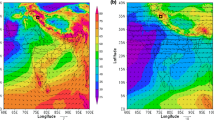Abstract
Electric field and Maxwell current density measurements made below thunderstorms at Pune (India) have been analyzed to study the charging processes occurring during dissipation stage of thunderstorms. These observations suggest that during the dissipation stage of thunderstorm different charging processes contribute to the cloud electrification depending on the type of thunderstorms. Our observations suggest that updraft may not be sufficient to activate charging mechanism inside cloud during the dissipation stage in small thunderstorms. However, in big thunderstorms, non-inductive charging mechanism may be active during the dissipation stage. The recovery curves of electric field and Maxwell current density measured during dissipation stage of inverted polarity thunderstorms suggests that inductive charging mechanism may also contribute to the thunderstorm electrification.












Similar content being viewed by others
References
Brooks IM, Saunders CPR (1994) An experimental investigation of the inductive mechanism of thunderstorm electrification. J Geophys Res 99:10627–10632
Bruning EC, Rust WD, MacGorman DR, Biggerstaff MI, Schuur TJ (2010) Formation of charge structures in a supercell. Mon Weather Rev 138:3740–3761
Dye JE, Willet JC (2007) Observed enhancement of reflectivity and the electric field in long-lived Florida anvils. Mon Weather Rev. https://doi.org/10.1175/MWR3484.1
Dye JE, Bansemer A (2018) Electrification in mesoscale updrafts ofdeep stratiform and anvil clouds in Florida. J Geophys Res 123:1021–1049. https://doi.org/10.1029/2018JD029130
Dye JE, Jones JJ, Winn WP, Cerni TA, Gardiner B, Lamb D, Pitter RL, Hallert J, Saunders CPR (1986) Early electrification and precipitation development in a small isolated Montana cumulonimbus. J Geophys Res 91:1231–1247
Deaver LE, Krider EP (1991) Electric fields and current densities under small Florida thunderstorms. J Geophys Res 96:22273–22281
Gaskell W, Illingworth AJ, Latham J, Moore CB (1978) Airborne studies of electric fields and the charge and size of precipitation elements in thunderstorms. Quart J R Meteorol Soc 104:447–460
Helsdon JH, Farley RD (1987) A numerical modeling study of a Montana thunderstorm: model results versus observations involving nonelectrical aspects. J Geophys Res 92:5645–5659. https://doi.org/10.1029/JD092iD05p05645(ISSN:0148-0227)
Illingworth AJ (1971) The variation of the electric field after lightning and conductivity within thunderclouds. Q J Meterol Soc 97:440–456
Kamra AK, Pawar SD (2007) Evolution of lightning in an isolated hailstorm of moderate size in the tropics. J Geophys Res 112:D20205. https://doi.org/10.1029/2006JD007820
Krider EP, Musser JA (1982) Maxwell currents under thunderstorms. J Geophys Res 87:11171–11176
Krider EP, Blakeslee RJ (1985) The electric currents produced by thunderclouds J. Electrostatics 16:369–378
Kuhlman KM, MacGorman DR, Biggerstaff MI, Krehbiel PR (2009) Lightning initiation in the anvils of two supercell storms. Geophys Res Lett 36. https://doi.org/10.1029/2008GL036650
Livingston JM, Krider EP (1978) Electric fields produced by Florida thunderstorms. J Geophys Res 83:385–401
MacGorman DR, Rust WD, Krehbiel PR, Rison W, Bruning EC, Wiens (2005) The electrical structure of two supercell storms during STEPS. Mon Weather Rev 133:2583–2607
Marshall TC, Stolzenburg M, Krehbiel PR, Lund NR, Maggio CR (2009) Electrical evolution during the decay stage of New Mexico thunderstorms. J Geophys Res 114:D02209. https://doi.org/10.1029/2008JD010637
Mason J (1988) The Generation of electric charges and fields in thunderstorms.
Moore CB, Vonnegut B (1977) The thundercloud. In: Golde RH (ed) Lightning, vol 1. Academic, San Diego, pp 51–98
Pawar SD, Kamra AK (2002) Recovery curves of the surface electric field after lightning discharges occurring between the positive charge pocket and negative charge centre in a thundercloud. Geophys Res Lett 29:2108–2111
Pawar SD, Kamra AK (2004) Evolution of lightning and the possible initiation/triggering of lightning discharges by the lower positive charge centre in an isolated thundercloud in Tropics. J Geophys Res 109:D02205. https://doi.org/10.1029/2003JD003735
Pawar SD, Kamra AK (2007) The end-of-storm-oscillation in tropical air-mass thunderstorms. J Geophys Res. https://doi.org/10.1029/2005JD006997
Pawar SD, Kamra AK (2009) The Maxwell current density characteristics below isolatedthunderstorms in tropics. J Geophys Res 114(D04208):1–12
Proc R Soc London Ser A Mathematical and Physical Sciences. 415:303–315
Qie X, Kong X, Zhang G, Zhang T, Yuan T, Zhou Y, Zhang Y, Wang H, Sun A (2005) The possible charge structure of thunderstorm and lightning discharges in northeastern verge of Qinghai-Tibetan Plateau. Atmos Res 76:231–246
Rolph G, Stein A, Stunder B (2017) Real-time Environmental Applications and Display sYstem: READY. Environ Mod Softw. https://doi.org/10.1016/j.envsoft.2017.06.025
Rust WD, MacGorman DR, Bruning EC, Weiss SA, Krehbiel PR, Thomas RJ, Rison W, Hamlin T, Harlin J (2005) Inverted-polarity electrical structures in thunderstorms in the severe thunderstorm electrification and precipitation study. Atmos Res 76:247–271
Standler RB, Winn WP (1979) Effects of coronae on electric field beneath thunderstorms, Q J R Meteorol. Soc 105:285–302
Stolzenburg M, Rust WD, Marshall TC (1998) Electrical structure in thunderstorm convective regions. 2. Isolated storms. J Geophys Res 103:14079–14096
Takahashi T (1978) Riming electrification as a charge generation mechanism in thunderstorms. J Atmos Sci 35:1536–1548
Wiens KC, Rutledge SA, Tessendorf SA (2005) The 29 June 2000 supercell observed during STEPS Part II: Lightning and charge structure. J Atmos Sci 62:4151–4177
Williams ER, Boccippio DJ (1993) Dependence 401 of cloud microphysics and electrification on mesoscale vertical air motion in stratiform precipitation. In: Conference on atmospheric electricity, St. Louis, MO, American Meteorology Society, pp. 825–831
Williams E, Mushtaka TV, Rosenfeld D, Goodman S, Boccippio D (2005) Thermodynamic conditions favorable to superlative thunderstorm updraft, mixed phase microphysics and lightning flash rate. Atmos Res 76:288–306
Wilson CTR (1920) Investigations on lightning discharges and on the electric field of thunderstorms. Philos Trans A 221:73–115
Wormell TW (1930) Vertical electric currents below thunderstorms and showers. Proc R Soc London Ser A 127:567–590
Acknowledgements
Authors are grateful to Dr A K Kamra for his interest and guidance during observations.
Author information
Authors and Affiliations
Corresponding author
Additional information
Responsible Editor: Maja Telisman Prtenjak.
Publisher's Note
Springer Nature remains neutral with regard to jurisdictional claims in published maps and institutional affiliations.
Rights and permissions
About this article
Cite this article
Gopalakrishnan, V., Pawar, S.D. & Domkawale, M.A. Charging processes during the dissipation stage of thunderstorms. Meteorol Atmos Phys 133, 467–478 (2021). https://doi.org/10.1007/s00703-020-00755-0
Received:
Accepted:
Published:
Issue Date:
DOI: https://doi.org/10.1007/s00703-020-00755-0



